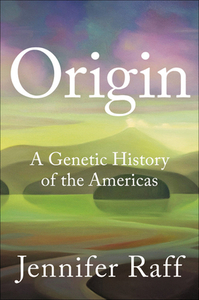Take a photo of a barcode or cover
I was skeptical at first because this book was not written by a person of Native American heritage, and could have quickly gone down a very slippery slope. But the author seems quite respectful of indigenous peoples and their interests, and constantly reiterates the importance of viewing the topic from a native perspective. Still, I would have liked to see a Native American co-author for this book.
In the bulk of the argument, the author reminds us of the theory that people arrived in the Americas towards the end of the last ice age by way of the Bering Land Bridge. At one point she suggests that that might not be the whole story - that perhaps some people arrived further south by sea as much as 15,000 years earlier than is commonly thought, which would account for the footprints recently uncovered in White Sands National Park and similar findings. However, that theory is mentioned almost in passing and we are left wondering.
The rest of the book is a discussion of the author's own genetic research, and the colonial implications of scientific investigation of the genetic ancestry of First Nations. Perhaps that was her true purpose in writing this book - to protest unethical scientific research and support the rights of indigenous communities.
In the bulk of the argument, the author reminds us of the theory that people arrived in the Americas towards the end of the last ice age by way of the Bering Land Bridge. At one point she suggests that that might not be the whole story - that perhaps some people arrived further south by sea as much as 15,000 years earlier than is commonly thought, which would account for the footprints recently uncovered in White Sands National Park and similar findings. However, that theory is mentioned almost in passing and we are left wondering.
The rest of the book is a discussion of the author's own genetic research, and the colonial implications of scientific investigation of the genetic ancestry of First Nations. Perhaps that was her true purpose in writing this book - to protest unethical scientific research and support the rights of indigenous communities.
informative
reflective
slow-paced
informative
reflective
medium-paced
informative
reflective
challenging
informative
reflective
sad
medium-paced
Raff is an anthropological geneticist interested in the origins of the First Peoples of the Americas. This book gives a nice survey of the theories in the field of anthropology in the Americas.
Positives about this book: Raff offers alternative perspectives and an overview of the evidence for and against. She does a really nice job explaining the duty of geneticists and archaeologists to work collaboratively with First Nations communities to design and develop scientific inquiries into their ancestors. I also really enjoyed the few moments of fancy where she imagines a tender scenario by which ancient remains came to be.
Overall, I found a lot of this book to be repetitive and wished she would detail the sites a bit more as well as put some of the locations into better context. Many of the sidebars were distracting and I wished they were woven in to the main text in many places. Minor, but there were several typos that the editors should have caught. Finally, the photos in the glossy pages were honestly a bit disappointing and I was confused about what portions of the text they corresponded to.
Positives about this book: Raff offers alternative perspectives and an overview of the evidence for and against. She does a really nice job explaining the duty of geneticists and archaeologists to work collaboratively with First Nations communities to design and develop scientific inquiries into their ancestors. I also really enjoyed the few moments of fancy where she imagines a tender scenario by which ancient remains came to be.
Overall, I found a lot of this book to be repetitive and wished she would detail the sites a bit more as well as put some of the locations into better context. Many of the sidebars were distracting and I wished they were woven in to the main text in many places. Minor, but there were several typos that the editors should have caught. Finally, the photos in the glossy pages were honestly a bit disappointing and I was confused about what portions of the text they corresponded to.
While I agree with other reviews that the book would have benefitted from more input from actual archaeologists, Raff nevertheless does a great job explaining the field of aDNA and it’s implications in tracing migration routes to the Americas. Occasionally dry but ultimately interesting and well researched.
challenging
informative
reflective
slow-paced
challenging
informative
slow-paced



